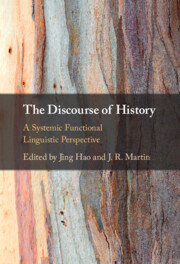132 results
B.6 Long-term risk of subsequent stroke after transient ischemic attack or minor stroke: a systematic review and meta-analysis
-
- Journal:
- Canadian Journal of Neurological Sciences / Volume 51 / Issue s1 / June 2024
- Published online by Cambridge University Press:
- 24 May 2024, p. S6
-
- Article
-
- You have access
- Export citation
3 - Cultivating the Value of Democracy in History Teaching
-
-
- Book:
- The Discourse of History
- Published online:
- 16 May 2024
- Print publication:
- 23 May 2024, pp 45-72
-
- Chapter
- Export citation
2 - Cultivating a Critical Gaze: Managing Technicality in Ancient History Teaching
-
-
- Book:
- The Discourse of History
- Published online:
- 16 May 2024
- Print publication:
- 23 May 2024, pp 16-44
-
- Chapter
- Export citation
References
-
- Book:
- The Discourse of History
- Published online:
- 16 May 2024
- Print publication:
- 23 May 2024, pp 322-337
-
- Chapter
- Export citation
Figures
-
- Book:
- The Discourse of History
- Published online:
- 16 May 2024
- Print publication:
- 23 May 2024, pp vii-viii
-
- Chapter
- Export citation
Copyright page
-
- Book:
- The Discourse of History
- Published online:
- 16 May 2024
- Print publication:
- 23 May 2024, pp iv-iv
-
- Chapter
- Export citation
Contents
-
- Book:
- The Discourse of History
- Published online:
- 16 May 2024
- Print publication:
- 23 May 2024, pp v-vi
-
- Chapter
- Export citation
Index
-
- Book:
- The Discourse of History
- Published online:
- 16 May 2024
- Print publication:
- 23 May 2024, pp 338-342
-
- Chapter
- Export citation
Preface
-
- Book:
- The Discourse of History
- Published online:
- 16 May 2024
- Print publication:
- 23 May 2024, pp xv-xvi
-
- Chapter
- Export citation
1 - Building Historical Knowledge through Language: A Systemic Functional Linguistic Perspective
-
-
- Book:
- The Discourse of History
- Published online:
- 16 May 2024
- Print publication:
- 23 May 2024, pp 1-15
-
- Chapter
- Export citation
Contributors
-
- Book:
- The Discourse of History
- Published online:
- 16 May 2024
- Print publication:
- 23 May 2024, pp xii-xiv
-
- Chapter
- Export citation
Tables
-
- Book:
- The Discourse of History
- Published online:
- 16 May 2024
- Print publication:
- 23 May 2024, pp ix-xi
-
- Chapter
- Export citation
Assessing associations between individual-level social determinants of health and COVID-19 hospitalizations: Investigating racial/ethnic disparities among people living with human immunodeficiency virus (HIV) in the U.S. National COVID Cohort Collaborative (N3C)
-
- Journal:
- Journal of Clinical and Translational Science / Volume 8 / Issue 1 / 2024
- Published online by Cambridge University Press:
- 21 May 2024, e107
-
- Article
-
- You have access
- Open access
- HTML
- Export citation

The Discourse of History
- A Systemic Functional Linguistic Perspective
-
- Published online:
- 16 May 2024
- Print publication:
- 23 May 2024
Protecting Your Friends: The Role of Connections in Division Manager Careers
-
- Journal:
- Journal of Financial and Quantitative Analysis , First View
- Published online by Cambridge University Press:
- 22 April 2024, pp. 1-34
-
- Article
-
- You have access
- Open access
- Export citation
Effectiveness of a WHO self-help psychological intervention to alleviate stress among healthcare workers in the context of COVID-19 in China: a randomised controlled trial
-
- Journal:
- Epidemiology and Psychiatric Sciences / Volume 33 / 2024
- Published online by Cambridge University Press:
- 07 March 2024, e11
-
- Article
-
- You have access
- Open access
- HTML
- Export citation
Incidence of mental health diagnoses during the COVID-19 pandemic: a multinational network study
-
- Journal:
- Epidemiology and Psychiatric Sciences / Volume 33 / 2024
- Published online by Cambridge University Press:
- 04 March 2024, e9
-
- Article
-
- You have access
- Open access
- HTML
- Export citation
Church and state in contemporary China: securing Christianity
-
- Journal:
- Politics and Religion / Volume 17 / Issue 1 / March 2024
- Published online by Cambridge University Press:
- 05 February 2024, pp. 107-137
-
- Article
-
- You have access
- Open access
- HTML
- Export citation
Design and construction of the near-earth space plasma simulation system of the Space Plasma Environment Research Facility
-
- Journal:
- Journal of Plasma Physics / Volume 90 / Issue 1 / February 2024
- Published online by Cambridge University Press:
- 11 January 2024, 345900101
-
- Article
- Export citation
Data-driven hypothesis generation among inexperienced clinical researchers: A comparison of secondary data analyses with visualization (VIADS) and other tools
-
- Journal:
- Journal of Clinical and Translational Science / Volume 8 / Issue 1 / 2024
- Published online by Cambridge University Press:
- 04 January 2024, e13
-
- Article
-
- You have access
- Open access
- HTML
- Export citation

